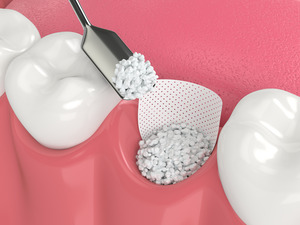
Before you can have dental implants placed, you may need to undergo certain preliminary treatments. In particular, you might require bone grafting to correct any bone loss that may have occurred due to your missing teeth. What does bone grafting entail? And why might it be a necessary step for revitalizing your smile with sturdy dental implant posts? The answers to these questions can be found below.
What Does Bone Grafting Involve?
Bone grafting is a procedure where grafting material is transplanted in order to rebuild a jawbone that has been damaged or otherwise weakened. The grafting material can be taken from another bone in your body (such as the hips or the chin), but if that’s not possible, it can come from a donor instead. Once the grafting material has been applied, you may need to wait several months before receiving dental implants. This gives the grafting material a chance to fully fuse with the jaw.
Why Might Bone Grafting Be Needed Before Dental Implant Surgery?
One of the consequences of losing teeth is that bone loss starts to occur in the jaw. This is because the jaw requires stimulation from your natural teeth in order to stay healthy. If teeth are missing, the lack of stimulation will cause the jaw to deteriorate.
For dental implants to be successful, a certain level of bone density is required. Thus, if the jaw has lost too much bone, it could affect your candidacy for the dental implant procedure. But if you have bone grafting performed, you may still be able to qualify for dental implants once your mouth and jaw have completely healed.
Additionally, if you have a tooth removed and plan on replacing it with a dental implant, a specific type of bone grafting known as socket preservation may be performed immediately after the extraction. This helps stop the jawbone from atrophying until the implant posts can be inserted.
How Will You Know If You Need Bone Grafting?
Not every patient is exactly the same. Depending on your circumstances, you may not need bone grafting at all prior to dental implant surgery. In order to find out for sure, you will need to schedule a dental implant consultation. During this visit, your dentist will use advanced technology to examine your mouth and jaw. By evaluating jawbone density and other factors, they will be able to determine what, if any, preliminary treatments are needed on your path toward a recompleted smile.
About the Author
Dr. Chase Smith studied dentistry at The Ohio State University, and he attended an Advanced Education in General Dentistry residency at the Dayton VA. Not only can Dr. Smith place dental implants in-office, but he also offers bone grafting for patients who might have experienced bone loss as a result of missing teeth. To schedule a consultation with Dr. Smith at Thornville Dental, visit his website or call (740) 246-5286.

